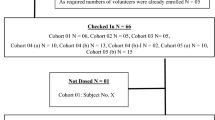Summary
Previous studies in our laboratory have shown that the semisynthetic bile acid derivative, sodium 3α,7α-dihydroxy-12-oxo-5β-cholanate (MKC), has hypoglycemic activity. The aim of this study was to investigate the relationship between the pharmacokinetics and hypoglycemic activity of MKC in healthy and diabetic rats. Groups of healthy and alloxan-induced diabetic rats were dosed intravenously (i.v.) and orally with MKC (4 mg/kg). Blood samples were taken before administration of the dose and at 20, 40, 60, 80, 120, 150, 180, 210 and 240 minutes post-dose. MKC serum concentration was measured by HPLC, and pharmacokinetic parameters determined using the WinNonlin program.
The absolute bioavailability of MKC was found to be low in healthy and diabetic rats (29 and 23% respectively) and was not significantly different between the two groups. Mean residence time (MRT), volume of distribution (Vd) and half-life (t1/2) of MKC after oral administration were significantly lower in diabetic than in healthy rats (21, 31 and 29% respectively). After the i.v. dose, the change in blood glucose concentration was not significant in either healthy or diabetic rats. After the oral dose, the decrease in blood glucose concentration was significant, reaching a maximum decrease from baseline of 24% in healthy rats and 15% in diabetic rats.
The results suggest that a first-pass effect is crucial for the hypoglycemic activity of MKC, indicating that a metabolite of MKC and/or interference with metabolism and glucose transport is responsible.
Similar content being viewed by others
References
Laurence D. R., Bennett P.N., Brown M.J. (1997): Clinical pharmacology, 8th edition. Singapore: Longman, 593–594. Novi Sad.
Repa J.J., Mangelsdorf D.J. (1999): Nuclear receptor regulation of cholesterol and bile acid metabolism. Curr. Opin. Biotechnol., 10: 557–563.
Peter N.C., Anthony D.S. (1994): Biochemistry illustrated. 3rd edition. Longman, Singapore, pp. 227–228.
Broughton G. (1994): Chenodeoxycholate: the bile acid. The drug. A review. Am. J. Med. Sci., 307: 54–63.
Gordon G.S., Moses A.C., Silver R.D., Flier J.S., Cary M.C. (1985): Nasal absorption of insulin: enhancement by hydrophobic bile salts. Proc. Natl. Acad. Sci. USA, 82: 7419–7423.
Kuhajda K., Kevresan S., Mikov M., Sabo A., Miljkovic D. (1997): 3α,7α-Dihydroxy-12-oxo-5β-cholanate as an enhancer of insulin nasal absorption in rats. Arch. Toxicol. Kinet. Xenobiot. Metab., 5: 359–361.
Miljkovic D., Kuhajda K., Mikov M., Kevresan S., Sabo A. (2000): US patent No. 6,060,465 on bile acids and their derivatives as glycoregulatory agents.
Kuhajda K., Kevresan S., Mikov M., Sabo A., Miljkovic D. (2000): Influence of 3α,7α-dihydroxy-12-oxo-5β-cholanate on blood glucose level in rats. Arch. Toxicol. Kinet. Xenobiot. Metab., 8: 304–308.
Nair P.P., Gracia C. (1962): A modified gas-liquid chromatography procedure for the rapid determination of bile acids in biological fluids. Anal. Biochem., 29: 164–166.
Ellin R.I., Mendeloff A.I., Turner D.A. (1962): Quantitative determination of 3,7,12-triketocholanic acid in biological fluids by gas-liquid chromatography. Anal. Biochem., 4: 198–203.
Armbruster D.A, Tillman M.D., Hubs L.M. (1994): Limit of detection (LOD) / limit of quantitation (LOQ). Comparison of the empirical and the statistical methods exemplified with GC/MS assays of abused drugs. Clin. Chem., 40: 1233–1238.
Win Nonlin program (version 1.1) (2005): Pharsight Corp. (Mountain View, CA)
Purves R.D. (1992): Optimum numerical integration methods for estimation of area under the curve (AUC) and area under the first moment curve (AUMC). J. Pharmacokinet. Biopharm., 20: 211–226.
Kern R.C., Foster J.D., Pitovski D.Z. (1997): Mineralocorticoid (type I) receptors in the olfactory mucosa of the mammal: studies with (3H) aldosterone and ami-mineralocortisoid spirolactone. Chem. Senses, 22: 141–148.
Taylor C.G., Zahradka P. (2004): Dietary conjugated linoleic acid and insulin sensitivity and resistance in rodent models. Am. J. Clin. Nutr., 79: 1164S-1168S.
Staels B., Auwerx J. (1997): Role of PPAR in the pharmacological regulaton of lipoprotein metabolism by fibrates and thiazolidinediones. Curr. Pharm. Design, 3: 1–14
Setchell K.D., Worthington J. (1982): A rapid method for the quantitative extraction of bile acids and their conjugates from serum using commercially available reverse-phase octadecylsilane bonded silica cartridges. Clin. Chim. Acta., 125: 135–144.
Rudman D., Kendall F.E. (1957): Bile acid content of human serum I. Serum bile acids in patients with hepatic disease. J. Clin. Invest., 36: 530–537.
Wasfi I.A., Elghazali M., Boni N.S., Hadi A.A.A., Alhadrami G.A., Almuhrami A.M., Alkatheeri N.A., Barezaig I.M., Agha B.A., Wajid S. (1999): The disposition of theophylline in camels after intravenous administration. J. Vet. Pharmacol. Ther., 22: 255–260.
Gonzalez J., Hidalgo F., Lopez M.A., Esteller A. (1983): Influence of bile salts on the endogenous excretion of bile pigments. Rev. Esp. Fisiol, 39, 69–75.
Simoni P., Cerre C., Cipolla A. (1995): Bioavailability study of a new, sinking, enteric coated ursodeoxycholic acid formulation. Pharm. Res., 31: 115–119.
Dow J., Lindsay G., Morrison J. (1996): Biochemistry molecules, cells and the body. Addison-Wesley Publishing, Boston, pp. 418–22.
Author information
Authors and Affiliations
Rights and permissions
About this article
Cite this article
Mikov, M., Boni, N.S., Al-Salami, H. et al. Bioavailability and hypoglycemic activity of the semisynthetic bile acid salt, sodium 3α,7α-dihydroxy-12-0X0-5β-cholanate, in healthy and diabetic rats. Eur. J. Drug Metabol. Pharmacokinet. 32, 7–12 (2007). https://doi.org/10.1007/BF03190984
Received:
Issue Date:
DOI: https://doi.org/10.1007/BF03190984




